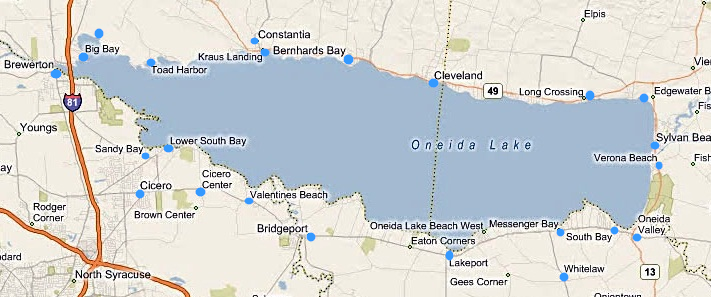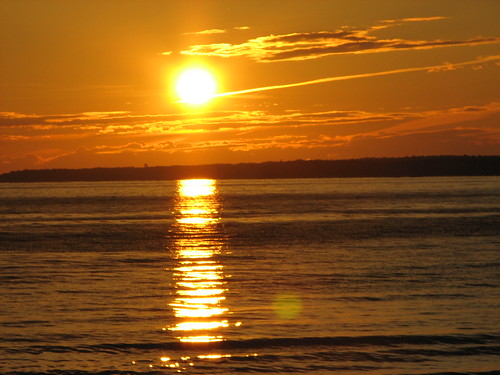Blue Highways: Somewhere on the North Side of Oneida Lake, New York
Unfolding the Map
 As we continue through New York, we happen with William Least Heat-Moon (LHM) upon Oneida Lake, the largest freshwater lake entirely within the state. This post is about framing, or specifically how a lake helps visually frame vistas. But it is also about something more. Books like Blue Highways frame an author's perspective and thoughts, and now I'm using these posts to frame my experience of Blue Highways and other books for you. Hopefully, you can use my posts to frame your own thoughts and create frames of perspective for others. To frame Oneida Lake geographically, please see the map.
As we continue through New York, we happen with William Least Heat-Moon (LHM) upon Oneida Lake, the largest freshwater lake entirely within the state. This post is about framing, or specifically how a lake helps visually frame vistas. But it is also about something more. Books like Blue Highways frame an author's perspective and thoughts, and now I'm using these posts to frame my experience of Blue Highways and other books for you. Hopefully, you can use my posts to frame your own thoughts and create frames of perspective for others. To frame Oneida Lake geographically, please see the map.
Book Quote
"The shingled cafe, Ben and Bernies, afforded a broad view of Lake Oneida....
"The Oneida shoreline was warm - too warm - for May, although maples by the highway had opened to a cooling shade. The perpetual spring I'd been following around the country was about done. On a map, Lake Oneida looks like a sperm whale, and my course that morning was down the spine, from the flukes to the snout. All along the shore, old houses, big houses, were losing to the North climate, and for miles it was a place of sag and dilapidation."
Blue Highways: Part 8, Chapter 6
 Sunset over Oneida Lake, New York. Notice how water, land, sky and sun work together so well in this picture. Photo by The Brit_2 and hosted at Flickr. Click on photo to go to host site.
Sunset over Oneida Lake, New York. Notice how water, land, sky and sun work together so well in this picture. Photo by The Brit_2 and hosted at Flickr. Click on photo to go to host site.
Somewhere on the North Side of Oneida Lake
I've always heard that when one takes a picture, framing the shot is the most important thing one can do to make sure that the picture is a good one. I've also watched videographers, and have seen television shows about how certain movies are made, and once again how shots are framed are very important.
What is framing? In photographic terms, framing focuses the viewer's attention on an object in the photo or in the scene, and in many cases can add a sense of depth to an image. So, why am I starting out a post centered on Oneida Lake with the concept of framing? I think I first became aware of this component of visual arts through my interaction with lakes.
I grew up next to the Pacific Ocean. When one looks west from my hometown, the ocean spreads flat as far as the eye can see. On some days, the view is to the horizon and on other days, if it is foggy, the eye cannot see as far. When looking out over the ocean, one seeks some kind of frame of reference, such as a boat or other object. I often found my eyes seeking the coastline, especially north where Cape Mendocino juts out into the ocean many miles distant, and I often found that a pleasing sight as it gave me a sense of distance and depth that I lacked looking straight west.
I probably had my first experience with a lake when I was too young to remember. My family used to make yearly winter trips from our home on the ocean to Lake Tahoe. They started this before I was born, and for some reason these trips ended when I was about four years old. I do not remember much about my couple of trips to Lake Tahoe at the time other than some disjointed images of the car ride and being in snow (which I hated at the time because I didn't like the cold).
The first time I remember seeing a lake and really appreciating it was when I was in junior high school. I was probably in 8th grade. I had a friend named Mike, and he lived with his mother. His father lived in Clearlake, California and Mike asked me if I would like to go with him to see his dad for the weekend. His dad was a pilot, and flew over to Little River Airport to pick us up. It was my first airplane ride, and as we followed Highway 20, which I knew well, I saw the limits of my world laid out for me. I noted the turn from Highway 20 onto U.S. 101 and followed its line down toward Ukiah - the route I knew so well from frequent trips to the orthodontist and the ophthalmologist.
Just beyond a low hill from U.S. 101, where I wouldn't have seen it from the road, lay a small lake. I asked about it, and learned it was Lake Mendocino, a large reservoir on the east fork of the Russian River. We were following Highway 20 again after it split off from 101 - a continuance that I wasn't aware of. There were a series of little lakes that followed along the road. I was told those were the Blue Lakes, and told some thought they were bottomless. Then, a much, much larger lake, Clear Lake, came into view. As we banked over and began our approach into Clearlake's airport, I was amazed by its size.
Since then, I have seen a number of lakes, some much bigger than Clear Lake, and have realized that everything is perspective. And to be fair to myself, Clear Lake is the biggest body of fresh water entirely in California. But at that time I never realized that there could be a volume of water, outside the ocean, that could be so big.
The time we spent on and around Clear Lake was fun. Mike's dad owned a motel with a pier into the lake and we spent time fishing, and he took us out in his boat and I learned to water ski for the first time. But what made the lake so fascinating was the view. Mount Konocti, a volcano, rises on the south shore of Clear Lake, and small hills ring it. The depression in which the lake lies and the flat blue water of the lake itself creates a natural frame. I think that my unconscious view was drawn to this frame of water, earth and sky and I would spend a lot of time looking toward the lake for that reason.
I've seen this effect at other lakes as well, including in New York where LHM travels first past the Finger Lakes and then past Oneida Lake. On a visit to a friend's parents' house at Geneva, New York, I was aware of a similar effect as I looked south down the long lake. Hills and sky frame the lake, and if an object such as a sailboat were on the lake in the distance, the combination of elements framed the boat beautifully.
I can imagine LHM coming upon Oneida Lake for the first time. The water appears, and the frame spreads as more water fills the field of vision and the shores spread out to the right and left. Depending on the time day, the sun might add to the effect. At dawn, as the sun rises, a trail of light might direct one's gaze toward where the sun is coming up if one is standing at the western end of the lake. One might see the same effect in the evening at the eastern end of the lake. The lake is long enough that one might not be able to see completely across its length, which in itself creates a frame for the eye. At the same time, standing on the north shore, the length of the south shore (if it can be seen - I don't really know) would draw the eye toward natural frames that the brain would recognize, giving depth and distance a meaning. I'm speculating, because I have never been to Oneida Lake, but that's the point of a book - to put these images in my mind that tap into my own experience.
I've always been one to really observe and see the art and beauty in the world around me. Some of my most memorable scenes, ones that are indelibly etched into my experience, are the vistas surrounding lakes, and I believe it is because of that natural framing that occurs that my unconscious, developing mind recognized and appreciated long before my conscious mind understood why.
Musical Interlude
The lyric "In and around the lake, mountains come out of the sky and they stand there" came into my mind as I was writing this post. To me, it almost perfectly encapsulates the effect a lake can have on one's vision. The lyric is from the song Roundabout by Yes. The rest of the lyrics can be seen if you go to the YouTube site for the video.
If you want to know more about Oneida Lake
New York Department of Environmental Conservation: Oneida Lake
Oneida Lake
Oneida Lake, New York
Wikipedia: Oneida Lake
Next up: Somewhere on the Erie Canal




 Saturday, May 26, 2012 at 9:30AM
Saturday, May 26, 2012 at 9:30AM